Exploring the Uses and Benefits of Black UV Flashlights
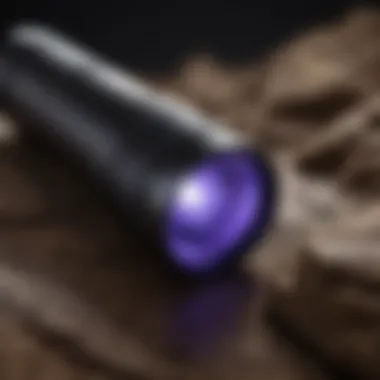
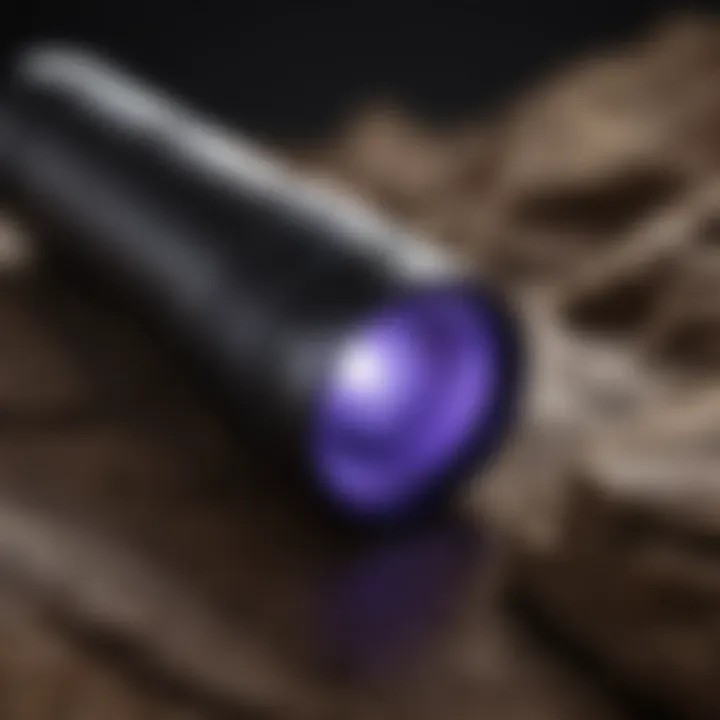
Intro
Black UV flashlights have carved out a unique niche in the world of collectibles, especially in the realms of rocks and fossils. The allure lies not just in their ability to emit a specific wavelength of light, but also in how they reveal details often invisible to the naked eye. This unique technology opens up a dialogue about the undying fascination with natural history, and how tools like the black UV flashlight enhance our understanding and appreciation of items we often take for granted.
These illuminating gadgets can unveil the hidden qualities of minerals and other specimens, making them invaluable for serious collectors and enthusiasts alike. Before diving deeper, it’s imperative to explore the roots of this technology and how it has evolved to serve the passionate community of collectors today.
Understanding Black UV Flashlights
Black UV flashlights serve a crucial role in various fields, notably in collecting and examining natural specimens. Their significance lies not just in the glow that reveals unseen wonders but also in the precise functionalities that cater to collectors, researchers, and enthusiasts alike. Grasping how black UV flashlights work is paramount for those looking to deepen their appreciation and understanding of minerals, fossils, and other collectibles.
Definition and Working Principle
A black UV flashlight emits ultraviolet light, which is a form of electromagnetic radiation that exists just beyond the visible spectrum. This type of flashlight typically operates between 100 to 400 nanometers in wavelength, a range where shorter wavelengths can highlight specific materials in a way that ordinary light cannot. When an object is exposed to these UV rays, it can fluoresce or phosphoresce, thereby revealing features or markings that are otherwise invisible to the naked eye.
The core mechanics of a black UV flashlight involve a few key components. At the heart of these devices is a bulb that generates UV light. Unlike standard incandescent bulbs, which emit warmth in addition to light, the UV lamps are designed to produce significantly less heat. This makes them more efficient for users who might be inspecting delicate specimens or when a high level of control is required over the examination process.
To sum it up, understanding how black UV flashlights work equips collectors with the knowledge to effectively use this tool, enhancing detection capabilities and refining their collection practices.
Different Types of UV Light
When discussing black UV flashlights, it is essential to understand that not all UV light is created equal. The types of UV lights can be categorized based on their wavelength, each having unique properties and applications:
- UVA (320-400 nm): Most commonly emitted by black UV flashlights, UVA is perceived as 'black light.' This wavelength effectively causes many substances to fluoresce. Collectors utilize UVA to spot hidden details on minerals or evaluate the integrity of artifacts.
- UVB (280-320 nm): This wavelength is less common for everyday use due to its hazardous effects on skin cells. However, it is used in specialized applications like certain types of phototherapy.
- UVC (100-280 nm): This category emits the most energetic UV light and is typically eliminated by the earth's atmosphere. It's used primarily in sterilization processes but not for practical everyday application in collecting.
The selective use of these different light types can either enhance or negate specific features of the items collectors engage with. Consequently, it is advisable for enthusiasts to choose their UV flashlight types with care, ensuring they match the demands of their specific applications.
The Science of Ultraviolet Light
Understanding the science behind ultraviolet (UV) light is essential when discussing the practical applications of black UV flashlights. Ultraviolet light, which resides just beyond the visible spectrum, is capable of revealing details and characteristics otherwise invisible to the naked eye. For rock and fossil collectors, this knowledge is not just academic; it’s a gateway to enhancing the discovery and understanding of various specimens. With the aid of black UV flashlights, collectors can gain insights into materials, their authenticity, and even hidden features that can change the game's rules altogether.
Spectrum of Light
The spectrum of light plays a crucial role in determining how we interact with different materials. Visible light makes up only a small portion of the electromagnetic spectrum, while UV light is divided into three main ranges: UVA, UVB, and UVC.
- UVA (longwave): This range is the most common in black UV flashlights. It can penetrate deeper into materials, making it great for exploring minerals and fossils. Theres often a plethora of fluorescence that can be spotted during UV light examination.
- UVB (mediumwave): While this is useful in certain applications, it's generally less effective in detailed inspections for collectors. It's often associated with sunburn effects in wildlife and humans.
- UVC (shortwave): This is more powerful but usually not employed in hand-held devices for collectors due to safety concerns.
It really is a wonder how something invisible can bring the whole world to life again, illuminating patterns and features long forgotten beneath layers of dust and time. By understanding the spectrum, collectors can effectively choose the right type of flashlight for their needs, focusing on those UV wavelengths that yield the most useful insights.
Effects on Materials
The impact of UV light on different materials cannot be understated, especially for those engaged in collecting. Various substances react differently when exposed to black UV light, leading to fascinating outcomes.
For instance:
- Fluorescence: Certain minerals and fossils exhibit fluorescence under UV light. This means they absorb light and then re-emit it, creating a glow that highlights their unique properties. Opal, for example, may display vibrant colors, unveiling hidden aspects that are otherwise overlooked in natural light.
- Identification of Inclusions: UV light can reveal inclusions within gems and fossils, which can help in determining their origin and authenticity. Amber, when exposed to UV rays, displays a distinct luminescence, assisting in the authentication of genuine specimens.
- Detecting Alterations: Modified or repaired collectibles may show inconsistent fluorescence patterns. For instance, if a fossil has been treated or restored, the altered sections may fluoresce differently compared to the original material.
Important Note: When using black UV flashlights, it’s critical to understand that some materials may degrade or be adversely affected by prolonged exposure. Understanding these effects ensures that collectors protect their valuable specimens while maximizing their research potential.
In summary, diving into the science of ultraviolet light equips rock and fossil collectors with tools to elevate their collecting experience. Knowledge about the spectrum and the effects on materials opens up a plethora of insights that can lead to better preservation, authentication, and appreciation of the natural treasures that so many seek.
Applications in Collecting
In the realm of collecting, particularly among enthusiasts of minerals and fossils, black UV flashlights serve as a crucial tool. They offer not just illumination but a deeper understanding and appreciation of the items that collectors cherish. Their ability to reveal nuances that the naked eye may overlook is what sets them apart, providing a significant edge in the collecting game.
Identifying Minerals and Fossils
Black UV flashlights excel in identifying minerals and fossils due to their capability to highlight specific features. For instance, certain minerals fluoresce under UV light, revealing vibrant colors and patterns that are invisible in standard lighting. This fluorescence is a telltale sign of a mineral's composition. Collectors can make quicker, more informed decisions when evaluating whether a specimen is genuine or something that has been artificially enhanced or altered.
Using a black UV flashlight in the field can transform the experience of a collector. Imagine scouring a rocky outcrop with the sun beating down, only to miss out on gems hiding from view. But once the UV light casts its magical glow, the rock face comes alive with an interplay of colors—an entirely new world unfolds before your eyes.
Disclosure of Repairs and Enhancements
Revealing the true nature of a specimen’s condition is critical for collectors. Black UV flashlights provide a clear advantage here. Repairs or enhancements can often be detected through the variations in fluorescence. For example, resin used in repairs might exhibit a different glow under UV light compared to the authentic material of the specimen.
Understanding this aspect can save collectors from expensive mistakes. If an item has been significantly altered, its market value may plummet. Thus, employing a black UV flashlight becomes a wise practice for anyone serious about collecting. Relying on traditional visual inspection alone could lead to a false sense of security about the item’s integrity.


Authenticating Artifacts
When it comes to authentication, black UV flashlights take the lead. In the world of artifacts—be it fossils, historic items, or crafted goods—the line between genuine and counterfeit can often be blurred. Some artifacts, particularly those that are mass-produced or brand new, may not exhibit signs of age or wear that one would expect.
UV light can expose underlying materials or coatings applied to primitive artifacts, revealing discrepancies that would not be apparent under regular lighting. Collectors often cite moments of realization when a seemingly simple artifact turns out to be something far more intriguing once scrutinized under a black UV flashlight.
"The glow that flickers through the darkness can tell stories of authenticity that mere surface inspection can't."
With the right equipment in hand, the world of natural history becomes not just a collection but an adventure filled with discovery and insight.
Benefits of Using Black UV Flashlights
Understanding the benefits of black UV flashlights is essential for anyone involved in collecting minerals, fossils, or various artifacts. Beyond their alluring glow, these tools offer significant practical advantages that efficiently enhance the value and enjoyment of the collector's experience.
Enhancing Visibility
One of the primary benefits of black UV flashlights is their ability to enhance visibility in ways that ordinary light sources cannot. Ultraviolet light can reveal features or details hidden to the naked eye, making it an indispensable tool for collectors. For instance, certain minerals fluoresce under UV light, emitting colors that do not appear in daylight. This phenomenon allows collectors to appreciate the true beauty of their specimens, bringing vibrant hues to life.
Moreover, black UV light can illuminate the presence of contaminants or substances that would otherwise go unnoticed. For example, when examining a fossil, the presence of oil or other organic materials might not be obvious in regular light. However, under UV exposure, these substances may fluoresce differently, providing critical insight into the specimen's history and preservation state.
Delineating Features in Specimens
Black UV flashlights excel at delineating intricate features within specimens. When examining complex materials such as agate or opal, the variations in texture and internal structures can be challenging to see clearly. Using a UV flashlight, collectors might uncover banding patterns or inclusions that contribute to the specimen's uniqueness. This detail not only enriches the collector's understanding but also assists in grading and evaluating the item's worth.
Additionally, UV light can help in detecting microfractures or other flaws that might not be obvious when inspected without such illumination. Identifying these features can prevent the purchase of damaged or poorly restored items, refining the collector's choices and investments.
Simplifying Identification Processes
Another significant advantage of black UV flashlights is their ability to simplify the identification process. Many minerals and gems have unique fluorescence characteristics. For instance, some calcite fluoresces a dull red, while certain fluorites may display vibrant greens or blues. This means that even for beginners, using a UV flashlight can create a shortcut to identifying and categorizing specimens more accurately.
"Owning a UV flashlight turned my collecting journey from overwhelming to crystal clear! I can spot rare varieties with confidence now." - A satisfied collector
Moreover, these flashlights can help in distinguishing between imitations and genuine articles. It’s not uncommon for collectors to encounter specimens that look similar but are fundamentally different. UV lights serve as reliable tools to differentiate authenticity—like spotting a real turquoise from stained charms that may look appealing but lack value.
In summary, the integration of black UV flashlights in the practice of collecting significantly boosts visibility, clarifies specimen features, and simplifies identification tasks. These tools are not merely helpful but transformational in enhancing a collector's ability to understand, appreciate, and accurately evaluate their treasures.
Comparing Different Black UV Flashlights
When it comes to selecting the right black UV flashlight, understanding the nuanced differences among various models is crucial. This section focuses on highlighting the key elements that influence the performance and user experience, allowing rock and fossil collectors to make informed decisions. Knowing which flashlight suits your specific needs can enhance your collection and improve your overall experience during fieldwork or in the lab.
Wavelength and Intensity Considerations
One of the most significant factors in comparing black UV flashlights is the wavelength of the emitted light. UV light is categorized generally into three regions: UVA, UVB, and UVC. For collectors, UVA light—which usually ranges from 320 to 400 nanometers—is typically favored, as it is effective for illuminating various materials without causing harm.
Intensity also plays a critical role. Higher intensity can lead to better visibility of fluorescent features in specimens. Nonetheless, too much intensity might result in early fatigue when using the flashlight for extended periods. A balanced approach is essential in finding the right wavelength and intensity for your applications.
- Pros of Higher Intensity:
- Cons:
- Better visibility for intricate features.
- Enhanced ability to differentiate minerals.
- Potential for eye strain.
- Can lead to more rapid battery usage.
Portability and Design Features
The portability of a black UV flashlight matters greatly for collectors, especially those who spend a lot of time outdoors. A lightweight model can make a world of difference when you’re traversing rocky terrains or carrying a host of other equipment. Moreover, design features like rubberized grips and adjustable angles enhance usability, allowing for better handling during specimen inspections.
A flashlight that fits snugly in your bag while remaining easy to handle is invaluable. When it comes to design:
- Look for compact models that have a holster or belt clip.
- Consider those with multiple light settings for greater versatility.
- Assess the durability, especially for fieldwork.
The right flashlight combines compactness with robust design, ensuring you can efficiently identify minerals and fossils wherever your adventures take you.
Power Source Options
A flashlight’s power source is equally critical when deliberating on the best model to add to your collection. Different flashlights may use replaceable batteries, rechargeable lithium-ion batteries, or even solar power in some innovative cases. Each type has its pros and cons, which can significantly impact your fieldwork.
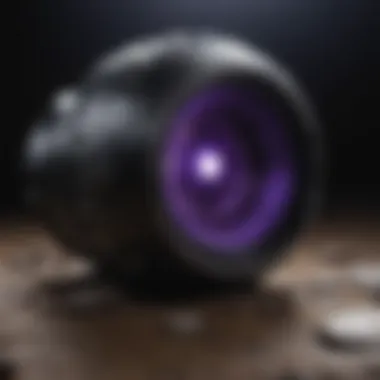
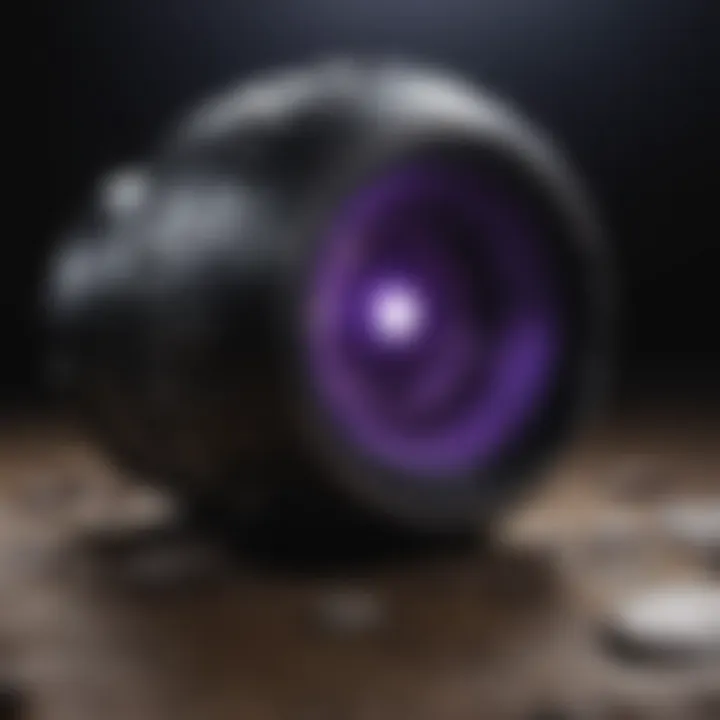
- Replaceable Batteries:
- Rechargeable Batteries:
- Solar Power:
- Pros: Easy to swap out, widely available.
- Cons: Ongoing costs and potential leakage over time.
- Pros: Convenient, can save you money in the long run.
- Cons: Limited run time may require frequent charging, especially in low-light conditions.
- Pros: Eco-friendly and cost-effective.
- Cons: Not always reliable without sufficient sunlight.
As a collector, you should consider how often you’ll use the flashlight and where, ensuring that your power source aligns with your needs.
A thoughtful choice of flashlight ensures that your exploration and discovery processes remain smooth and enjoyable.
In sum, if you’re looking to step up your collection game, it pays to compare these varied aspects of black UV flashlights, taking careful consideration of the ones that best fit your collecting habits and environments.
Safety Precautions When Using UV Flashlights
Using black UV flashlights can be a game changer for rock and fossil collectors, but before diving headfirst into their practical applications, being mindful of safety is paramount. Ultraviolet light, while beneficial for examining specimens, can also pose certain risks to both eyes and skin. Understanding these hazards and taking appropriate precautions not only ensures a safer experience but also maximizes the benefits of using these tools effectively.
Eye Protection Measures
The eyes are windows to the world, but they’re also vulnerable to UV rays. Ordinary light may not warrant much thought when it comes to eye protection, but UV light is a different beast altogether. Extended exposure can lead to serious issues like photokeratitis or cataracts. Recognizing this risk is crucial for anyone using black UV flashlights for prolonged periods.
- Invest in quality eyewear. Specialized UV-blocking glasses are a necessity. Look for lenses that specify UV protection features, which cut out harmful rays while preserving visibility of objects you’re examining.
- Regularly check for damage. Ensure that your eyewear is scratch-free and hasn’t been degraded over time. Just like your specimens, these tools must be kept in good condition for optimal results.
- Take breaks. If you’re using the flashlight for extensive periods, make sure to take scheduled breaks. This will give your eyes a chance to recover and reduce fatigue.
"An ounce of prevention is worth a pound of cure." Keeping your eyes safe while using UV flashlights can prevent a lot of discomfort down the road.
Skin Exposure Considerations
While we often think about protecting our eyes, skin exposure to UV light is equally critical. Just a few minutes of careless exposure could lead to sunburn-like effects or worse, long-term skin issues. Dark or light, all skin types are at risk.
Here’s how you can safeguard yourself when wielding black UV flashlights:
- Cover up appropriately. Wearing long sleeves and pants is a good start. Fabrics that tightly weave together can act as a barrier to UV rays.
- Apply sunscreen. For exposed areas, a broad-spectrum sunscreen with high SPF is prudent. Remember to reapply it regularly, especially if you’re outdoors and sweating.
- Be aware of reflectivity. Surfaces like water, glass, or even sandy ground can bounce UV rays back at you. Be mindful of your environment and adjust your positioning if needed.
In short, while black UV flashlights are excellent tools to reveal hidden aspects of your collectibles, safety should never be an afterthought. Care for yourself while going about your explorations promotes both enjoyment and longevity in this fascinating hobby.
Integrating Black UV Flashlights with Other Tools
Integrating black UV flashlights with various tools enriches the experiences of rock and fossil collectors. This practice serves several functions. It enhances their ability to examine and evaluate specimens, ultimately leading to a more thorough understanding of the materials they are dealing with. Several specific elements come into play when considering how these flashlights can be optimally integrated with other tools.
One major aspect is the improvement in accuracy when assessing features in specimens. For example, combining a black UV flashlight with magnification devices enables collectors to observe intricate details in minerals or fossils that might otherwise be hidden under normal light conditions. This not only aids in identification but also reveals the authenticity and quality of the pieces being examined.
Furthermore, the dual use of UV light alongside these instruments broadens the horizons for collectors. The ability to see fluorescence or other characteristics under UV light allows for a more nuanced examination of specimens, while magnification offers a close-up view. Adopting this integration approach can lead to better-informed decisions regarding purchase or preservation of items.
Benefits of Integration
Some key benefits of integrating black UV flashlights with other tools include:
- Enhanced Visibility: Makes it easier to spot unique features in the specimens.
- Depth of Detail: Reveals structural aspects that are invisible under natural light.
- Improved Identification: Facilitates more accurate identification by illuminating specific traits
Combining with Magnification Devices
Using black UV flashlights in conjunction with magnification devices can genuinely transform the examination process. Collectors often rely on tools like loupes or microscopes to get a closer look at their specimens. When adding a UV flashlight, the process becomes dynamic.
For instance, certain minerals fluoresce under UV light, and this characteristic can help collectors identify variations that might not be immediately evident to the naked eye. While looking at a mineral under magnification, the glow induced by the UV flashlight can highlight essential aspects, allowing users to determine if there are enhancements or repairs in the material. This integration not only ensures a thorough examination but also protects the integrity of the collection by making it easy to spot alterations.
Using alongside Digital Imaging
The fusion of black UV flashlights with digital imaging tools also represents a significant step forward for collectors. By leveraging digital cameras or scanners with a UV flashlight, one can create a detailed record of specimens under differing light conditions. This process can reveal textures, colors, and features invisible in standard light settings.
Photographs taken in UV mode can serve multiple purposes:
- Documenting Specimens: Collectors can maintain a visual log that tracks changes over time.
- Research and Comparisons: The images can aid ongoing research, allowing for comparisons with similar specimens in different collections.
- Online Sharing and Engagement: With platforms like Reddit or Facebook, sharing detailed images can stimulate community discussions and improve knowledge sharing.
In essence, integrating black UV flashlights with tools like magnification devices and digital imaging not only upgrades the capabilities of collectors but also contributes to a more thorough and enjoyable collecting experience.
User Experiences and Case Studies
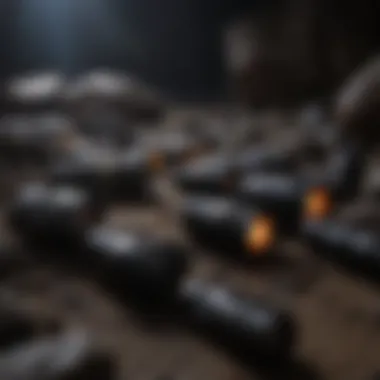
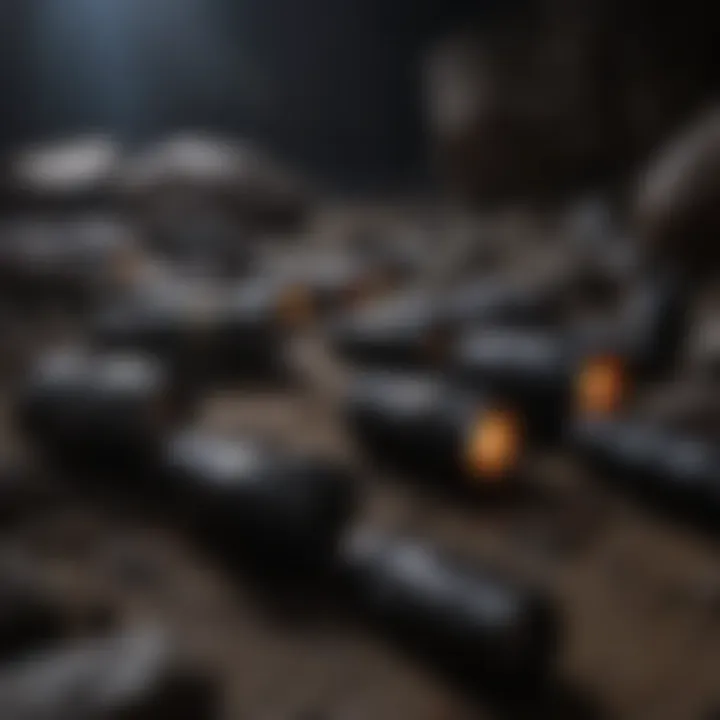
The world of black UV flashlights is filled with fascinating stories and firsthand accounts that showcase their utility. For collectors of rocks and fossils, these devices are not merely gadgets; they are invaluable tools that open up new horizons in the realm of collecting. Anecdotal experiences contribute significantly to understanding the practical applications of these flashlights and illustrate their significance in enhancing the overall collecting journey.
Collector Testimonials
Users across various collecting circles have shared experiences that elevate the black UV flashlight from a simple tool to an essential companion. Many collectors have testified about the thrill they felt when using these flashlights to unearth hidden details that the naked eye simply couldn't discern.
For instance, one fossil enthusiast recounted a discovery made during a visit to a local quarry. Armed with a black UV flashlight, they illuminated a layer of rock and were astounded to see previously invisible fluorescent minerals that hinted at a rich fossil bed. Not only did it boost their collection, but it also intensified their appreciation for the natural world.
Another noted collector of rare gemstones highlighted how black UV flashlights helped to authenticate materials. They used the light to inspect a supposedly rare diamond, revealing fluorescent traits that confirmed its authenticity. The sentiment echoed by many is that the integration of such technology fosters a deeper connection to the materials they collect.
- Enhanced detection of variances in mineral properties
- Facilitated authentication of prized specimens
These testimonials highlight how black UV flashlights enrich the collecting experience, providing insights that might have otherwise gone unnoticed. The emotional connection that collectors form with these tools is underscored by the excitement they feel each time they illuminate something new.
Field Research Insights
Field research serves as a pivotal backdrop where black UV flashlights play a crucial role. Through hands-on studies conducted in diverse environments, researchers have been able to document how ultraviolet light interaction with minerals leads to significant findings.
One particular study focused on the examination of cave formations. Researchers employed black UV flashlights to monitor the luminescent properties of calcite formations in a cave. The flashlight divulged information about mineral impurities that shaped geological formations over millions of years, allowing researchers to gain insights into the environmental conditions of that time. The outcomes not only added depth to the geological narrative but also showcased the versatility of black UV flashlights in both educational and research settings.
By combining their expertise in geology with these innovative tools, researchers have effectively opened new doors of understanding.
- Increased insights into mineral composition
- Better understanding of environmental conditions through luminescence
The experiences shared by both collectors and researchers signify the deep-rooted impact of black UV flashlights. The tools facilitate a new level of engagement, fostering a greater appreciation of nature's wonders, while providing critical data that could reshape how we understand and interpret various geological phenomena.
"The light has a way of showing what is not immediately obvious; it’s like a hidden language of nature revealed under a new lens."
Through these accounts and studies, it's apparent that black UV flashlights serve not only as functional devices but as transformative instruments that elevate the collecting process into something more profound.
Future Developments in UV Technology
As we look ahead, the advancements in ultraviolet (UV) technology stand to reshape the landscape of black UV flashlights. These developments are not mere upgrades; they are the forking paths unlocking newer applications and heightened efficiency in detecting and analyzing materials. The transition into a future filled with enhanced UV technology pivotal for collectors reveals the underlying significance of these emerging trends.
Advances in Light Emission
One of the critical areas making waves is the advances in light emission technologies. Manufacturers are now channeling their focus into refining the wavelength output of UV flashlights. This holds weight because even small variations in wavelength can deeply affect the visibility and reaction of various substances under UV light.
- Longer-lasting LEDs: The technology behind light-emitting diodes (LEDs) has rapidly evolved, which results in flashlights with greater durability and energy efficiency. Collectors can expect less frequent battery changes, allowing for uninterrupted examination of items.
- Tunable wavelengths: Some cutting-edge devices are now integrating tunable wavelengths. These allow users to adjust the light to target specific materials, which is beneficial when dealing with varied specimens.
- Enhanced thermal management: As light emission technologies aim for higher output without overheating, improved thermal management systems are becoming standard. This enhancement helps in preserving the lifespan of the flashlight and ensures safety during extended use.
Such advances don’t just enhance functionality—they directly translate to better experiences in the field. Collectors who depend on the nuances of UV light to identify details in minerals or fossils will find themselves better equipped than ever.
Potential New Applications
With every stride in UV technology, we can see a domino effect leading to potential new applications. What was once confined to specialized fields can now be extended to various disciplines, benefiting rock and fossil collectors and beyond.
- Archaeological site analysis: Imagine using black UV flashlights to reveal layers or features of artifacts that would otherwise go unnoticed. This application can unearth crucial details, making it easier for collectors to understand the context and history behind their finds.
- Forensic investigations: The cross-over into forensics isn’t far-fetched. UV light is pivotal in crime scene investigations. The renewed interest in merging these domains could lead to collaboration, thereby expanding the vitality and credibility of black UV flashlights.
- Storage and preservation: The role UV light can play in monitoring the condition of artifacts is another area worth exploring. New technology may allow flashlights to integrate humidity and temperature sensors, helping collectors keep track of their specimens before issues occur.
The sky is not even the limit; with the right innovations, we could be looking at applications that enhance how we perceive, preserve, and appreciate our natural history artifacts.
"The future's not some place we are going to, but one we are creating." - John Schaar
In summary, the unfolding realm of UV technology is ripe for exploration. The value of staying abreast of these advances is paramount for any collector serious about their artifacts. Embracing the future of UV flashlights is not merely an upgrade—it's an opportunity to set themselves apart in a field that increasingly values precision and innovation.
Concluding Thoughts
In wrapping up our exploration of black UV flashlights, it becomes clear that their value extends far beyond mere illumination. For collectors, whether of minerals or fossils, these tools are indispensable allies in the pursuit of authenticity and beauty in specimens. Understanding the significance of these flashlights helps in appreciating their role in revealing details that the naked eye often misses.
Summarizing the Value of Black UV Flashlights
Black UV flashlights stand as a gateway to a deeper understanding of the natural world. Their utility in identifying minerals, spotting repairs, and enhancing the visual characteristics of collectibles cannot be underestimated. By illuminating objects with UV light, collectors can:
- Reveal hidden features: Many minerals fluoresce under UV light, showcasing colors that are invisible to the eye in normal conditions.
- Uncover repairs: Some enhancements done to fossils might not be apparent at first glance; UV light can help detect glues or coatings that may have been used in restoration efforts.
- Authenticate items: By using black UV flashlights, collectors can validate the authenticity of artifacts or collectibles, ensuring that what they possess is genuine.
The scientific underpinning of ultraviolet light is crucial, as it enables collectors to make informed decisions. Having the right tool at hand enriches the collecting experience, transforming it from a simple hobby into a scientifically backed passion.
Encouragement for Exploration and Usage
As we look to the future, it’s evident that the applications of black UV flashlights are still unfolding. The encouragement for enthusiasts to incorporate these tools into their collection routines is more pertinent than ever. Not only do they enhance visibility, but they also open doors to newfound knowledge. Collectors intrigued by geology, archaeology, or art restoration should consider practical usage.
Don’t let hesitations stand in the way of discovery! Here are some tips for fruitful exploration:
- Experiment with different distances: Adjusting the distance between the flashlight and the specimen can reveal different features.
- Combine with other techniques: Use in tandem with magnification tools or photography to document findings.
- Share knowledge: Engage with fellow collectors in communities such as Reddit or relevant Facebook groups to exchange insights and tips.



